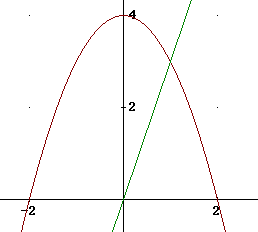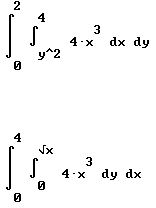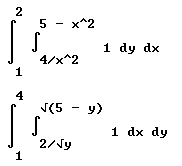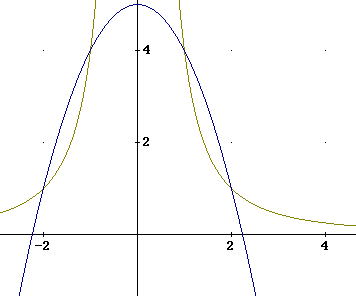
If your solution to stated problem does not match the given solution, you should self-critique per instructions at
http://vhcc2.vhcc.edu/dsmith/geninfo/labrynth_created_fall_05/levl1_22/levl2_81/file3_259.htm
.
Your solution, attempt at solution. If you are unable to attempt a solution, give a phrase-by-phrase interpretation of the problem along with a statement of what you do or do not understand about it. This response should be given, based on the work you did in completing the assignment, before you look at the given solution.
At the end of this document, after the qa problems (which provide you with questions and solutions), there is a series of Questions, Problems and Exercises.
Question: `q001. Evaluate the double integral Int( Int((x^2* e^xy) dy), 0, x) dx, 0 , 1)
Your solution:
Confidence rating:
Given Solution: First note, and be sure you understand, that an antiderivative of e^(x y) with respect to y is 1/x e^(x y). Then it should be clear that an antiderivative of x^2 e^(x y) with respect to y is x^2 * 1/x e^(x y) = x e^(x y).
The change in this antiderivative from y = 0 to y = x is x e^(x^2) - x.
We now integrate this expression from x = 0 to x = 1. An antiderivative of this expression is 1/2 e^(x^2) - x^2 / 2. Between x = 0 and x = 1 this changes by (1/2 e - 1/2) - (1/2) = 1/2 e - 1.
[Our antiderivative of x e^(x^2) is obtained by the substitution u = x^2 do that du = 2 x dx and x dx = du / 2, giving us int( 1/2 e^u du ) = 1/2 e^u. ]
Self-critique (if necessary):
Self-critique rating:
Question: `q002. Integrate 4x over D with respect to A using a double integral where D is the region bounded by y = 4 - x^2, y = 3x, and x = 0.
y = 4 - x^2 is a parabola opening downward with vertex at (0, 4). It intersects the x axis when y = 0, so the x coordinates of the intersection are the solutions to the equation 0 = 4 - x^2. We easily conclude that the parabola intersects the x axis at (-2, 0) and at (2, 0). At this point we are confined to the part of the parabola above the x axis, which is the part lying between x coordinates -2 and 2.
y = 3 x intersects y = 4 - x^2 when 3 x = 4 - x^2, which occurs when x^2 + 3 x - 4 = 0. The equation is easily solved by factoring or by the quadratic formula, giving us x = -4 and x = 1. The x = -4 point lies outside our x interval [-2, 2] but the x = 1 point lies within it. At the x = 1 point our y value is 3, as seen by substituting x = 1 into either the quadratic or the linear function.
You should be able to plot the bounding functions, one of which is linear and the other quadratic, without the aid of a graphing calculator. The graph looks like this:

The region bounded by our functions can be described by x cross sections or y cross sections.
In terms of x cross sections:
-2 <= x <= 0, 0 <= y <= 4 - x^2 AND 0 <= x <= 1, 3x <= x <= 4-x^2.
In terms of y cross sections, we first note that if y = 4 - x^2 then x = +- sqrt(4 - y), and if y = 3 x then x = 1/3 y. Then our cross sections are easy to describe:
0 <= y <= 3, -sqrt(4 - y) <= x <= 1/3 y AND 3 <= y <= 4, -sqrt(4 - y) <= x <= sqrt( 4 - y).
We integrate 4x over the given region. Our result could be
int ( int ( 4 x dy), 0 , 4-x^2) dx, -2, 0 ) + int ( int ( 4 x dy), 3x, 4-x^2) dx, 0, 1 )
int ( int ( 4 x dx, -sqrt(4-y), y/3) , 0, 3 ) +int ( int ( 4 x dx, -sqrt(4-y),sqrt(4-y)) dy, 3, 4 )
In symbols:
Either way, the integral of 4 x over the region is -13. Integration is straightforward.
Your solution:
Confidence rating:
Given Solution:
Self-critique (if necessary):
Self-critique rating:
Question: `q003. Compute the following integral with the given order of integration and with the order changed: Int[ Int(4x^3 dy, 0, sqrt(x)) dx, 0, 4].
Your solution:
Confidence rating:
Given Solution:
The region is 0 <= x <= 4, 0 <= y <= sqrt(x).
This region was used in one of the q_a_ problems for section 12.1.
The bounding curve is y = sqrt(x), which can also be expressed as x = y^2, y > 0.
x values from 0 to 4 result in y values from sqrt(0) = 0 to sqrt(4) = 2.
y cross-sections run from the curve to the line x = 4, so our region can be described by
0 <= y <= 2, y^2 <= x <= 4.
Our integral is therefore
int( int( 4 x^3, x, y^2, 4), y, 0, 2) = 4096 / 9.
The two integrals would be written in standard form as

Self-critique (if necessary):
Self-critique rating:
Question: `q004. Give two different ways to set up the integral of the area of the region D where D is the region in the first quadrant of the xy-plane bounded by y = 4/x^2 and y = 5 - x^2. Evaluate one of these integrals.
Your solution:
Confidence rating:
Given Solution:
You should easily and without the aid of a graphing calculator be able to sketch reasonable graphs of these functions. You will see that they intersect in two points of the first quadrant.
To find the coordinates of these points:
The curves y = 4 / x^2 and y = 5 - x^2 intersect at the x coordinate such that 4 / x^2 = 5 - x^2.
Solving the equation:
4 / x^2 = 5 - x^2. Multiply both sides by x^2 to get
4 = 5 x^2 - x^4. Rearrange to get
x^4 - 5x^2 + 4 = 0. Let u = x^2 to get
u^2 - 5 u + 4 = 0. Factor to get
u = 4 or u = 1. Replace u with x^2 to get
x^2 = 4 or x = 1, which leads to solutions
x = 1 and x = 2.
The intersection points are (1, 4) and (2, 1)
Between x = 1 and x = 2 the parabola is the higher of the two curves.
The region could be described as
1 <= x <= 2
4/x^2 <= y <= 5 - x^2
with resulting area integral
int ( int ( dy, 4/x^2, 5-x^2) dx, 1, 2)
Alternatively we first note that y = 4 / x^2 and y = 5 - x^2 are equivalent in the first quadrant to the respective curves x = sqrt(y) / 2 and x = sqrt( 5 - y). y values between our two intersection points run from 1 to 4. So our region is
1 <= y <= 4
sqrt(y) / 2 <= x <= sqrt( 5 - y )
with resulting area integral
int ( int ( dx, 2/sqrt(y), sqrt( 5 - y) ), y, 1, 4)
Both integrals yield the same result, 2/3, which is therefore the area of the region.
The integrals in standard form, and the graph of the two function, are depicted below.


Self-critique (if necessary):
Self-critique rating: